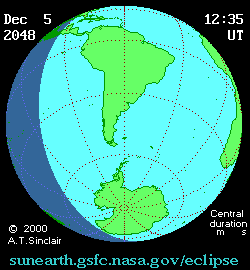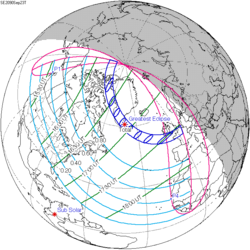| Total eclipse | |
| Gamma | −0.3973 |
|---|---|
| Magnitude | 1.044 |
| Maximum eclipse | |
| Duration | 208 s (3 min 28 s) |
| Coordinates | 46°06′S56°24′W / 46.1°S 56.4°W |
| Max. width of band | 160 km (99 mi) |
| Times (UTC) | |
| Greatest eclipse | 15:35:27 |
| References | |
| Saros | 133 (47 of 72) |
| Catalog # (SE5000) | 9616 |
A total solar eclipse will occur at the Moon's ascending node of orbit on Saturday, December 5, 2048, [1] with a magnitude of 1.044. A solar eclipse occurs when the Moon passes between Earth and the Sun, thereby totally or partly obscuring the image of the Sun for a viewer on Earth. A total solar eclipse occurs when the Moon's apparent diameter is greater than the Sun's, blocking all direct sunlight. Totality occurs in a narrow path across Earth's surface, with the partial solar eclipse visible over a surrounding region thousands of kilometres wide. Occurring about 16.5 hours before perigee (on December 6, 2048, at 8:00 UTC), the Moon's apparent diameter will be larger. [2]
Contents
- Images
- Eclipse timing
- Places experiencing total eclipse
- Places experiencing partial eclipse
- Eclipse details
- Eclipse season
- Related eclipses
- Eclipses in 2048
- Metonic
- Tzolkinex
- Half-Saros
- Tritos
- Solar Saros 133
- Inex
- Triad
- Solar eclipses of 2047–2050
- Saros 133
- Metonic series
- Tritos series
- Inex series
- References
- External links
The path of totality will be visible from parts of Chile, Argentina, Namibia, and Botswana. A partial solar eclipse will also be visible for parts of southern and central South America, Antarctica, and Southern Africa.






































































































